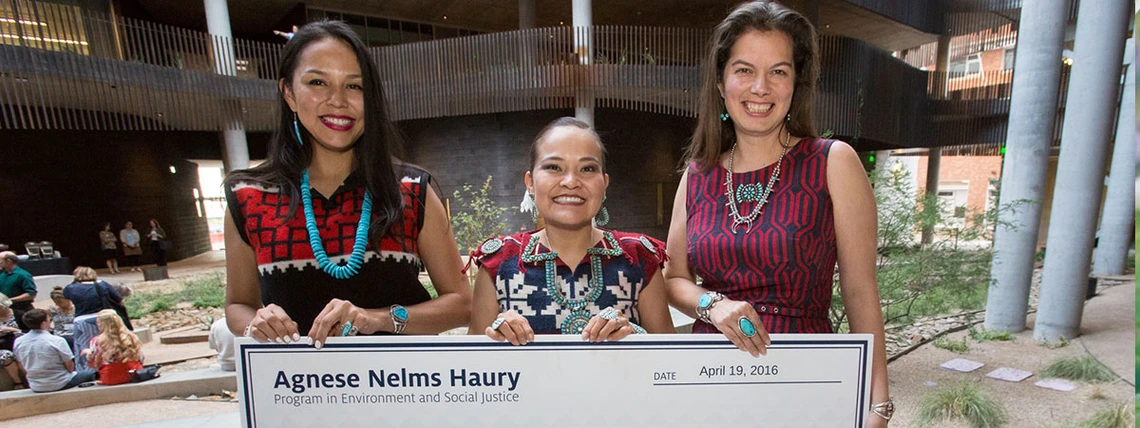Haury Program Inaugural Challenge Grant Awarded

The Agnese Nelms Haury Program in Environment and Social Justice (Haury Program) awarded the inaugural challenge grant in to K’é bee da’ahiiniita: Strength Through the Diné (Navajo) Clan System to Respond to the Gold King Mine Spill in an event open to the public on April 19 2016. The $600,000 Haury award will fund the project for three years. Karletta Chief and Paloma Beamer of the University of Arizona lead the team on this project. Other team members are:
- Janene Yazzie, To’Bee Nihi Dziil,
- Mae-Gilene Begay, Navajo Community Health Representatives,
- Perry Charley, Diné College,
- Jani Ingram, Northern Arizona University,
- Manley Begay, Northern Arizona University,
- Rebecca Clausen, Fort Lewis College,
- Nicolette Teufel-Shone, University of Arizona, and
- Dean Billheimer, University of Arizona.
More than a short-term response to a particular spill, the goal of this project is much larger. The team will make valuable inroads to the “wicked problem” of empowering communities and making diverse voices heard. Such voices are critical if the society is to generate solutions to problems and create paths to an improved social foundation. The K’é bee da’ahiiniita: Strength Through the Diné (Navajo) Clan System team plans to create transformational change in the relationship of the Diné to the US government and other entities by building tribal capacity through training of Diné tribal college students, environmental interns, and community health representatives.
The Haury Program funding complements a $434,000 rapid-response grant from the National Institute of Environmental Health Sciences (NIEHS) awarded to the team earlier this year to assess short-term exposure and risk perceptions of the Gold King Mine spill. The Haury Program project will leverage the team building and findings of the NIEHS project to create broader and longer-term capabilities regarding environmental issues.
There are estimates of over 500,000 abandoned mines in the US, many with potential to impact health and economies of local communities. Developing a successful model of capacity building related to spill response has great potential to be valuable not only to the Diné but to communities vulnerable to environmental problems throughout the world.
This project was one of three finalists chosen in an open competition in Fall 2015. The other teams, Promoting Social Equity through Community Energy Partnerships and Sowing Social and Environmental Justice through School Gardens, also included strong partnerships between community groups and University of Arizona researchers. The Haury Program provided all three teams with $10,000 to develop feasibility studies and their presentations as part of the final element in the challenge grant program. “It was a very difficult choice for our judges as all three projects have potential to make outstanding and transformative changes in the community,” stated Anna H. Spitz, Director of the Haury Program. “We hope that all three teams are able to leverage support and funding to implement their projects and have the impact they certainly promise in their communities.”
The Haury Program will open the next call for challenge grant proposals in early fall 2016.
For more about the Gold King Mine Spill, visit news articles such as http://www.latimes.com/nation/la-na-ff-navajo-qa-20151125-story.html or http://navajotimes.com/reznews/heated-controversy-ripples-from-gold-king-spill/.
For more about the K’é bee da’ahiiniita: Strength Through the Diné (Navajo) Clan System to Respond to the Gold King Mine Spill team, visit https://uanews.arizona.edu/story/toxic-spill-researchers-win-600k-haury-challenge-grant?utm_source=uanow&utm_medium=email&utm_campaign=biweekly-uanow
To view the April 19, 2016 team proposal presentation, visit https://youtu.be/tvfKOtPbpJ4
